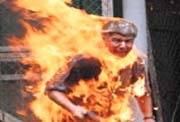Legal Measures to Combat Cult Violence: Continuous monitoring of the individuals active in cults Since the cults spread their threat among the societies throughout the world and nations experienced a great cult scare, the need to establish agencies and regulating laws to monitor the activities of suspicious groups and cults seemed to be an inevitable preventive measure. From the Manson family to the Moonies, the Waco sect to the Jonestown massacre, the activities of cults prompt great public concern and many NGOs and government-run agencies have devoted their resources to monitoring the activities of deviant groups. In the US alone the media continually warn of the dangers of cultic brainwashing strategies and the FBI continues to monitor closely religious groups they perceive to be potential dangers. Despite the great public and governmental attention afforded to detect destructive cults and sects, however, still a great number escape unnoticed.
The role of government to establish effective procedures besides constant monitoring of the individuals that are known to be active in certain cults is of great importance. Moreover, to ascertain the social security and build a protective wall against the threat of the cults, the government might maintain a militant protection which thereby obligates it to monitor and, if necessary, take action against destructive cults operating in a country. Indeed, it is not in any way against the practice of democracy to determine which cult or organizations or associated members have to come under the scope of a cult-monitoring activity since the society may suffer irreparable damages after unwarned, psychopathic attack or operation of a cult. In fact, it is people’s right to know and be informed of possible threats of cults and as Singer states:
Without the citizenry being aware of the power and control certain cults are wielding, democracy and freedom can be curbed one step at a time. 1
It has to be noted that because of unsettling presence of cults more people are susceptible to the threats of cults and in the same way it requires strenuous task to monitor the activists and activities. Moreover, in some occasions cults take advantage of existing flaws in the law to evade prosecution. For instance, Japan’s Aum Supreme Truth cult, responsible for a Tokyo subway gas attack which killed 12 people and injured thousands, escaped outlaw under Japan’s anti-subversion laws in January 1997 because a legal panel ruled there was no reason to believe it could still be a threat to society. Although Japan’s Public Security Investigation Agency later in 1999 conducted further investigations and began close monitoring of the cult activities with a view to re-apply for anti-subversion laws, there was no guarantee that the cult would not engage in further destructive and menacing operations.
In Iran, because of hypocritical nature of Mojahedin-e Khalq Organization (MKO/MEK), the organization managed to escape security scrutiny of the newly established government. The result was irremediable for the government and the nation. It cost Iran at least two tragic explosions in the prime minister’s office and the main office of the Islamic Republic Party killing the late president Rajaee and his prime minister and more than seventy key Iranian figures. Expelled from Iran, MKO continued its clandestine activities in other countries. In Germany, for example, it was after a two-year close monitoring of the government that the group’s illegal fundraising activities were discovered:
In Germany, the government uncovered the Mojahedin’s financial activities. After a two year investigation, the German High Court on 21st December 2001 closed the Mojahedin ‘shop’ – twenty-five houses and bases – after evidence was found of misuse of Social Security and fraud. 2
Then, it becomes evident that fundraising activities of the cults, although seemingly harmless at the first look, helps equipping the cult, if it is a terrorist cult like MKO, with sophisticated, destructive arms for military operations. The devoted members of cults are motivated to engage in fundraising activities with remarkable results. As Anne Singleton, a Briton ex-member of MKO, explains:
When Maryam came to Europe in 1993, she brought with her a totally dedicated force who undertook any task required. They set about taking over from the supporters’ role of fundraising. With their bullying tactics, their productivity far exceeded anything seen before. Some were able to return up to 1500 pounds sterling, per day. But even before this, in one year alone, Iran Aid charity in the UK had a declared income of 5 million pounds. Its undeclared income has been estimated at over twice this, making a total of over 15 million pounds in one year. If this amount is multiplied for just ten countries: UK, USA, Canada, France, Germany, Italy, the Netherlands, Sweden, Norway and Denmark, then an annual amount of 150 million pounds can be estimated to have made its way to the Mojahedin organisation. If this is multiplied over ten years, then the figure of 1.5 billion pounds gives a rough estimate of the resources which Massoud Rajavi has amassed through the efforts of his devoted followers only in the streets of the West. 3
In France too, it cost the government a high price before discovering the threatening, cult nature of MKO residing there in Paris. Suspecting that MKO’s headquarters acted as the cells of plotting terrorist and cult-like activities, the French police raided its headquarters in the vicinity of Paris and arrested its leader, Maryam Rajavi, and a number of her accomplices. Reported by the Figaro after the police’s raid:
The PMOI has carried out a number of activities on French soil that are clandestine, sectarian, delinquent, and even seriously criminal. In France, tile organisation has two or three hundred militants and sympathisers. Its ‘hard nucleus’ is made up of a few dozen militants. 4
The following shocking activities by the members of MKO proved that the police had acted on the basis of confidential reports; more than twenty members set themselves on fire in the streets of Paris and other European cities with two consequent deaths. The danger of cultism isn’t always restricted to be suspicious of a cult but activities and its members whose monitoring can sound the alarm before it is too late.


References:
1. Thaler Singer, Margaret; Cults in Our Midst: The Continuing Fight Against Their Hidden Menace, introduction, XXVIII.
2. Anne Singleton; Saddam’s Private Army, Iran-Interlink, 2003.
3. ibid.
4. Antoine Gessler; Autopsy of an Ideological Drift, Translated by Thomas R. Forstenzer, 2004, p. 95.

